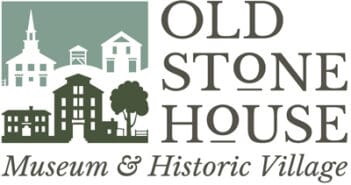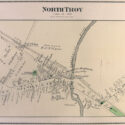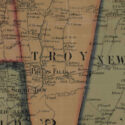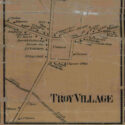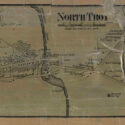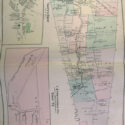Town History
From the Vermont Historical Gazetteer, edited by Abby Maria Hemenway. Orleans County – Troy Chapter: By Samuel Sumner . Published by Claremont Manufacturing Co, 1877. Pgs 309-336.
The town of Troy is oblong and irregular in its form, being 11 1/2 miles in length from north to south, whilst the north line is about 5 miles, and its south line about 2 miles in length. The general face of the country is that of two great slopes or inclined plains, extending from the summits of the two chains of mountains to their common center- the Missisco river.
PONDS AND STREAMS.
There are no natural ponds of any size in the Missico valley; the regular slope and steep ascent of hills preventing the accumulation and retention of water to make them. Neither are there many streams or brooks of much size. Near the confluence of the Missisco with the North or Potton Branch, a stream of considerable size called Mud Creek, unites with the Missisco river from the east. The Missisco river, which, with the mountains, is the most prominent feature of the valley, rises in the chain of hills or highlands, southwest of the country, separating the waters of the Lamoille from the streams running into Missisco and Lake Memphremagog. The first water-fall suitable for mills is about a mile below Troy village, at Phelps’s Falls. Below these falls, the meadows are not so continuous; high rocky bluffs occasionally appear intermingled with frequent tracts of fertile intervals.
The river then runs to the Village of North Troy, where there is an excellent fall for mills, and, three-fourths of a mile below North Troy crosses the state line into Canada.
ROCKS AND MINERALS
The two great chains of mountains which enclose the valley, on the east and on the west, are composed of rock similar to other parts of the Green Mountain range. Granite appears in the valley of Lake Memphremagog; but none is found in the Missisco valley, or further west, except occasional boulders, among loose stones. The most striking features of the valley are the immense ranges of serpentine and soapstone. The eastern range contains the veins of magnetic iron ore, which supplied the furnace at Troy. The quantity is inexhaustible; but the ore contains titanium, and is hard to smelt. The iron when manufactured is of the best quality, having great strength and hardness. It is finely adapted to make wire, screws, &c. It would make the best kind of rails for railroads. Should a railroad be constructed in the Missisco valley, this ore will be of immense value to the County and State. The principal mine of iron ore was discovered in 1833: it lies in the central part of the town of Troy, in a high hill, about three-fourths of a mile east of the river.
CHAPTERS AND GRANTS OF LAND.
The town of Troy was originally granted in two gores of nearly equal extent; the north to Samuel Avery, and the south to John Kelley, in 1792. Westfield was granted to Daniel Owen and his associates in 1780. All or nearly all the grantees of this town resided in Rhode Island. These towns at the time they were chartered were remote from any settlement, and some of them had been granted 20 years before any settlement was made in them.
In 1797, a Mr. Morrill moved into Troy, and erected a house about half a mile east of the village of North Troy, and probably was the first white man who ever wintered in the valley. In the fall of 1798, Josiah Elkins moved his brother Curtis Elkins into Potton, and they erected a house on the place called the Bailey farm, about half a mile north of the line. The house was built of logs of course, but they cut, split, and hewed basswood logs, for their supply of boards and shingles. Curtis Elkins remained with his family during the winter in this house.
Several families moved into Troy and Potton in 1799, and in the winter of 1799 and 1800, a small party of Indians, of whom the chief man was Capt. Susap, joined the colonists, built their camps on the river, and wintered near them. These Indians were represented as being in a necessitous and almost starving condition, which probably arose from the moose and deer (which formerly abounded here) being destroyed by the settlers. Their principal employment was making baskets, birch-bark cups and pails, and other Indian trinkets. They left in the spring and never returned. They appeared to have been the most numerous party, and resided the longest time of any Indians who have ever visited the valley since the commencement of the settlement.
One of these Indians, a woman called Molly Orcutt, exercised her skill in a more dignified profession, and her introduction to the whites was rather curious. In the Fall or beginning of the Winter in 1799, one of the settlers purchased and brought in a barrel of whiskey and two half barrels of gin and brandy. The necessities of the people for this opportune supply may be inferred from the fact the whole was drank or sold and carried off within three days from its arrival. The arrival of a barrel of liquor in the settlement was, at that time, hailed with great demonstrations of joy, and there was a general gathering at the opening of the casks. So it was on this occasion, a large party from Troy, Potton, and even from Richford, were assembled for the customary carousal. Their orgies were held in a new house, and were prolonged to a late hour of the night.
A transient rowdy from abroad by the name of Perkins, happened there at that time, and in the course of the night grew insolent and insulting, and a fight ensued between him and one Norris, of Potton. In the contest Norris fell, or was knocked into a great fire that was burning in the huge Dutchback chimney which was in the room. Norris’ hair and clothes were severely scorched, but the main injury he sustained was in one hand which was badly burned. The flesh inside of the hand was burned, or torn off by the fall, so that the cords were exposed. The injury was so serious that it was feared he would lose the use of his hand. A serious difficulty now arose; there was no doctor in the settlement, no pain extractors or other patent medicines had found their way there, and no one in the valley had skill or confidence enough to undertake the management of so difficult a case. Molly Orcutt was known as an Indian doctress and then resided some miles off, near the Lake. She was sent for, and came and built her camp near by, and undertook the case, and the hand was restored. Her medicine is an application of warm milk-punch. Molly’s fame as a doctress was now raised. The dysentery broke out with violence that Winter, particularly among children, and Molly’s services were again solicited, and she again undertook the work of mercy, and again she succeeded. But in this case Molly maintained all the reserve and taciturnity of her race, she retained the nature of her prescription to herself, she prepared her nostrum in her own camp, and brought it in a coffee pot to her patients, and refused to divulge the ingredients of her prescription to any one; but chance and gratitude drew it from her.
In the March following, as Mr. Josiah Elkins and his wife were returning from Peacham, they met Molly at Arnold’s mills in Derby as she was on her way across the wilderness to the Connecticut river, where she said she had a daughter married to a white man. Mr. Elkins inquired into her means of prosecuting so long a journey through the forest and snows of Winter, and found the was but scantily supplied with provisions, having nothing but a little bread. With his wonted generosity Mr. Elkins immediately cut a slice of pork of 5 or 6 pounds out of the barrel he was carrying home, and gave it to her. My informant remarks she never saw a more grateful creature than Molly was on receiving this gift. “Now yon have been so good to me, “she exclaimed, “I will tell you how I cured the folks this Winter of the dysentery,” and told him her receipt. It was nothing more nor less than a decoction of the inner bark of the spruce.
The town of Troy, or as it was then called Missisco, was organized in March, 1802.
It appears that the good citizens voted £6, of lawful money to be expended on roads, and $10.00 to defray the expenses of the town for the year. From that time the town of Troy has had a regular corporate existence.
The sugar maple was a rich blessing to the early settlers of Vermont. Those beautiful groves yielded an abundant supply of sugar, affording to the indigent settler a necessary and luxury of life which the wealthy in older countries could scarce afford, whilst the cheerful fires of this wood, which, in our infancy, we saw blazing in the old stone-backed chimneys call up recollections of an enjoyment we cannot now find in the dull invisible warmth of an air-tight stove, and the ashes of this generous tree, when manufactured into potash -or pearlash, furnished an article for exportation, and almost the only one which would warrant the expense in transporting it to the then distant markets.
In 1804, Mr. Josiah Elkins erected a mill in Troy. Deacon Hovey had a grist ground there in October of that year-the first grist that ever was ground in Troy.
PROGRESS OF THE VALLEY.
During the 10 years following, the fortunes of the Missico valley were advancing, and society seems to have been improving. Farms were improved, new lots were purchased and settled; and the census, taken in 1830, shows that the population of Troy had almost trebled in 10 years, increasing from 227 in 1820, to 608 in 1830. Some new branches of mechanical business had been commenced, and the people had made considerable advance in the comforts and conveniences of life. Yet they were far from being a wealthy community or their situation a desirable one for an intelligent and prosperous people. Few of the farmers produced more than was needed for the use of their own families and for the supply of the mechanics and laborers in the immediate vicinity. None of the great staple articles were then extensively cultivated and only one farmer in the valley had any surplus produce to send to a distant market. Money was loaned at a rate of interest from 12 to 25 per cent. The laborious process of making ashes and selling them to the merchants, or to some owner of an establishment for manufacturing pearlashes, was almost the sole resource of many to obtain small sums of money, or to purchase those necessaries of life which were procured from abroad.
Two merchants traded at that time in the valley. The largest establishment was kept at the place now known as Troy village. The stock of goods commonly consisted of a hogshead of whisky and another of molasses, and a barrel of two of rum or other spirits. The assortment of cloths a stout man might carry on his shoulders, and tile crockery and hardware might be packed in a handcart or wheelbarrow. At North Troy another store was kept on a rather smaller scale. The roads into the valley were ill wrought and in the worst locations, and over almost impassible mountains. The most traveled route was the old Hazen road crossing the two chains of Lowell mountains from Craftsbury to Montgomery, a route which has of later years been pretty much deserted by man and surrendered to the beasts of the forest.
A mail from Craftsbury to St. Albans passed and returned on this road once a week, and a branch or local mail from Troy connected with this route in Lowell. In 1828 the Burlington and Derby road as it was called, was surveyed and partially made, entering the valley on the south through a natural ravine, from Eden, and passing through the towns of Lowell and Westfield to Troy village, thence turning east through Troy and Newport to the “narrows” of the lake. By this route a remarkably easy and level road was made into the valley from the south and a much more feasible and level route to the east than had ever before been enjoyed. The valley no longer remained in the inaccessible and isolated state it had previously been in. A large share of the travel and business from Burlington and Lake Champlain to this County passed over this road. Intersecting the principal roads, and crossing the valley at Troy village, business and travel was concentrated there. Another merchant established himself there in 1829, several mechanics settled there, and Troy, or South Troy village, became an important location in the county.
The year 1833, was distinguished by an event from which much was at the time anticipated and from which important consequences will sometime be realized-the discovery of the iron mine in Troy. Some years previous, specimens of the ore had been found in detached rocks or boulders which had attracted attention, and had been pronounced by some scientific men to be iron, and the existence of it in large veins or quantities in the vicinity had been conjectured. But the discovery of the mine was made in 1833, by Mr. John Gale. Mr. Gale was a blacksmith, and had resided in Troy for a few years previous to the war of 1812. Whilst he resided in Troy, he discovered a rock which from its color and weight attracted his attention and led him to suspect it might be iron. After he left Troy, he resided some years in the iron region west of Lake Champlain, and, from the knowledge he there acquired of ore, was confirmed by the belief that the lodge he saw in Troy contained iron.
Returning to this vicinity on a visit, he, with Harvey Scott, Esq., of Craftsbury, commenced search for this ore, in which he was joined by Thomas Stoughton, Esq. of Westfield. After searching some days, Mr. Gale discovered the vein of ore lying, as he thought, at or near the spot where he had discovered it more than 20 years before. He broke off some specimens of the rock and tested their value by melting them down in a blacksmith’s forge and hammering them into horsenails. The discovery of this ore occasioned a great excitement in the vicinity, and extravagant expectations were formed of the value of the mine. The ore was first discovered on lot No. 90, in the south gore in Troy. The owner of that lot, Mr. Fletcher Putnam, gave a deed of one half of the ore to the discoverers, according to the promise he had made them when they commenced their researches. A forge was erected at Phelps’ Falls, in 1834, by several individuals in Troy, and the manufacturing of the ore commenced. The owners of this forge were soon discouraged, and, in the winter following, they sold their forge, ores
and machinery, to Messrs. Binney, Lewis & Co., of Boston. These gentlemen obtained an act of incorporation from the Legislature of the State, and commenced making wrought-iron, but with little success, and they soon discontinued the business. The forge has been abandoned and has fallen into a heap of ruins. In 1835, another company was formed and incorporated in the Legislature, and in the name of the Boston and Troy Iron Company. This company purchased three-fourths of the ores, and 20 acres of land where the ores were situated, commenced operations, and built a furnace, a large boarding-house and other buildings, in 1837. After expending large sums of money, without realizing much profit, this company failed in 1841, and the lands, ores and buildings passed, by mortgage, into the hands of Mr. Francis Fisher, of Boston.
In 1844 Mr. Fisher put the furnace again in blast, and commenced the manufacture of iron, with the prospect of making it a permanent and profitable business, but these expectations were destroyed by the alteration of the Tariff in 1846, and like many other iron establishments in the United States, the operations of this furnace were then suspended, and have not since been resumed.
Thus far the iron mines of Troy have not answered the expectations which were formed from them, nor justified the outlay which has been made in the manufacture. As yet it has proved an injury rather than a benefit to the people in the vicinity, and a heavy loss to all who have engaged in the manufacture. But the richness of the ore is undoubted and from the abundant supply of charcoal and excellence of the water-power the facilities for manufacturing are great, and the iron produced from this ore, for durability, toughness, and strength, is not exceeded by any in America. The causes of the past failures are to be attributed to the difficulty of melting and fluxing the ore, the want of experience in the workmen, the fluctuations in the tariff, the remoteness of the location from water or railroad communication, and the difficulty of finding access to markets
PROGRESS FROM 1854 TO 1864
Since 1854, the seasons have generally been favorable and crops good to the present time, and the wealth and business of the town has been steadily advancing; and if our progress has not been as great as might have been expected from the advantages we possessed, yet perhaps it has been as great as we find on comparison with other communities. The farmers have turned their attention more to cultivating their farms, to increasing and improving their stock of cattle and sheep, and producing the great staple articles of beef butter and wool. The extension of the Connecticut and Passumpsic Railroad in 1864 to the head of Lake Memphremagog, Newport, a point within 8 or 10 miles of us has been an important era in the history of this section, and has entirely changed the state of things and course of business in this part of the State. Our people find that they can now sell their surplus produce, and buy the foreign articles they may need much more advantageously than before the road was constructed.
Many articles, such as lumber, hemlock bark &c., which formerly were almost valueless, as having only a local and limited demand, can now be carried to the rail-road, and sold for remunerating prices. This has facilitated the clearing of our wild or forest lands, and has greatly enhanced their value. But still greater and more lasting advantage has been derived from the rail-road by the ready sale and improved prices which our farmers can get for their produce, particularly in the article of butter. Our farmers can now churn their butter, carry it in the night following to the depot, and in the next day it may be carried to the market, and in the morning following, even in the hottest part of our summer, may be placed on the breakfast-tables of our city friends in Massachusetts as fresh and as nice as when taken from the dairy-room where it was manufactured.
Stimulated by these advantages, our farmers have increased the number of their cows, and thus increased the quantity and improved the quality of the product of their dairies, and better tilled and fenced their farms, and rendered them more productive. With this increase of their incomes houses and buildings have been made more comfortable and convenient and labor, stimulated to greater exertions, has been remunerated by advanced wages. With this increased wealth, there has been an evident increase of the comforts of life among the mass of the people. They are better fed and clothed, and with less labor than formerly; their houses and furniture prove that they made an advance in prosperity and refinement. If the moral and mental improvement of the community has kept pace with its pecuniary prosperity, the desires of the most sanguine philanthropist would seem to be satisfied.
RELIGIOUS AFFAIRS.
In 1842, a Baptist meeting-house was erected in Troy village, principally by the exertions and influence of Elder Downs, who then officiated as the Pastor of the Baptist church. In 1845 the Congregational Church in Troy was divided, and a second church of that order was organized, consisting of members residing in Troy village and in the south part of the town, who held their meetings alternately with the Baptists, in the house at South Troy. A meeting house was erected in 1848, at North Troy, under the control of the Baptists, though designed for and used by both the Congregational and Baptist societies. In 1863, the Congregational Society erected a house for public worship at South Troy, and in 1864 a house was built by the Congregational society at North Troy.
There are also some families of Irish and French Canadians who have settled among us, who are Roman Catholics. They have but rarely any religious services, but reject all union or connection with other sects or forms of worship.
EDUCATION AND LITERATURE.
The inhabitants of the Missisco valley have never been distinguished by any very great attainments in science and literature. Though many instances may be cited of more than ordinary natural talents, and the general intelligence of the people is admitted, yet it must be confessed that the intellectual powers have not been cultivated and improved to that point which elevates society and humanity to their highest state of refinement and improvement. The cause of this slate of things, it is, perhaps, useless to investigate, and the consequences which have followed this neglect of mental culture it may be offensive to point out. No schools or seminaries of learning above the common district-school have been maintained in the valley, until within a few years past. In 1855 an academy was incorporated at North Troy, and in 1857 another was incorporated in Westfield. Schools have as yet been maintained in them only for portions of the year. No young man, born and reared in the valley, has ever received a collegiate education, except Rev. W. W. Livingston, son of Dea. Livingston of Potton. There are no public libraries in Troy, except for sabbath schools, and but few private libraries of much value. Newspapers and periodicals are our principal reading matter.
